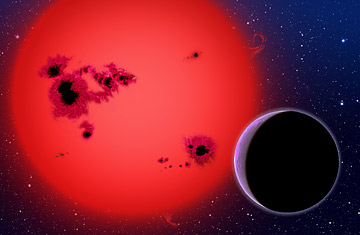
An international has spotted a new planet 2.7 times bigger than Earth, circling a dim red star called GJ 1214, just 40 light-years away in the constellation Ophiuchus.
Back in the mid-1990s, when astronomers were just beginning to find new planets around distant stars, nearly every new discovery got front-page headlines. Today, with the extrasolar-planet count up to about 400, it takes something extraordinary to make news.
But extraordinary may be too understated a descriptor for the discovery reported on Wednesday in the journal Nature: an international team led by Harvard astronomer David Charbonneau has spotted a "super-Earth," a planet 2.7 times bigger than Earth, circling a dim red star called GJ 1214, just 40 light-years away in the constellation Ophiuchus. "It's spectacular," says Geoffrey Marcy of the University of California, Berkeley, who is the world's most prolific planet hunter and is credited with discovering 70 of the first 100 exoplanets. "It's a top-of-the-top discovery in the quest for Earth-size planets."
While the new planet, dubbed GJ 1214b, is too big to be considered Earth-like, it comes pretty close. But GJ 1214b's relatively compact size — smaller than the vast majority of planets identified so far — is only one reason for astronomers' enthusiasm. Another is GJ 1214b's likelihood of bearing the stuff of life: water.
If you're looking for a world where life might thrive, a planet must be at the right temperature for water to exist in liquid form. So it needs to orbit its star in the so-called habitable zone, a "Goldilocks" location that allows a planet to be neither too hot nor too cold. In that respect, GJ 1214b is again a near miss. Its surface temperature hovers at a sweltering 190°C (374°F), which is well above the boiling point of water, at least in Earth's atmospheric pressure. Fortunately, GJ 1214b's atmosphere makes the pressure a lot higher than on Earth — "crushing," as Charbonneau describes it — and increases the odds of liquid water. (Under pressure, water can remain liquid above 100°C, or 212°F.)
Astronomers were further able to estimate the planet's makeup by calculating its size, based on the amount of light that GJ 1214b blocked when it passed in front of its star, as well as its mass (6.6 times Earth's mass), based on the wobble in the wavelength of starlight caused by GJ 1214b's gravitational pull on its star. That analysis revealed the new planet's density: about one-third of Earth's. Because water has a much lower density than rock, astronomers figured that the "most plausible scenario is a planet made mostly of water, with a significant atmosphere," says Charbonneau. So despite its high temperature, GJ 1214b's high atmospheric pressure and relatively low density mean liquid water could exist there after all.
Nevertheless, it's too soon to suggest that astronomers have found the site of potential exoplanetary life. "What you want [for life] is a nice toasty ocean with a little bit of atmosphere. That's not going to happen here," says Charbonneau. "I think it would be foolish to say categorically that [GJ 1214b] doesn't have life. But we have no basis for thinking it could."
If it does, astronomers will be able to look for it in unprecedented detail. Since GJ 1214b is only 40 light-years away, which is practically next door in cosmic terms, its atmosphere can be studied more closely than that of any other exoplanet, both with the Hubble Telescope and with the infrared-sensitive Spitzer Space Telescope. Charbonneau's team has already applied for observing time on both scopes to do just that.
Perhaps the most exciting thing about the discovery of GJ 1214b is that the planet was found at all. Planet hunters usually focus their attention on Sun-like stars — that is, large and hot — on the assumption that if you're looking for life, you should look in a place that is as similar to our solar system as possible. Charbonneau, however, focused on about 2,000 small, dim, red stars known as M-dwarfs, nearby Earth. M-dwarfs are much more numerous than Sun-like stars; of the 300 stars closest to Earth, says Charbonneau, 220 or so are M-dwarfs. They're also much cooler than Sun-like stars, so their habitable zones are close-in. A planet in the Goldilocks position around an M-dwarf doesn't take a year to orbit, as Earth does; it takes only a few days (1.6 days, in the case of GJ 1214b). So astronomers need to wait only a few days to spot a planet passing by, and only a few weeks to confirm the orbit with several passes.
M-dwarfs are so small, moreover, that an Earth-size planet casts a relatively big silhouette as it passes in front of it, making the telltale dimming of starlight easy to spot. It's so easy, in fact, that Charbonneau didn't even need a giant telescope to see it. Instead, he got away with the kind of scope a serious backyard amateur might use. In other words, says Charbonneau, "we did it on the cheap."
They also did it fast. "We thought it would take us two years to find something like GJ 1214b," says Charbonneau. "It took just six months. Either we got really lucky, or these planets are common." If they are, then it wouldn't be surprising for astronomers to find planets that are slightly smaller and slightly cooler — in short, more Earth-like — as well.
Charbonneau's group isn't the only one looking. An international consortium of observatories just announced the discovery of several other super-Earths around Sun-like stars, though these new planets are far too hot to sustain life and too far away to be able to study. Separately, NASA's Kepler Mission will present the first results of its planet search at the American Astronomical Society meeting in Washington in January. "[The Kepler team] has already submitted 28 scientific papers based on 43 days of data or less," says MIT planet theorist Sara Seager. "It's going to be a big year for planets."
